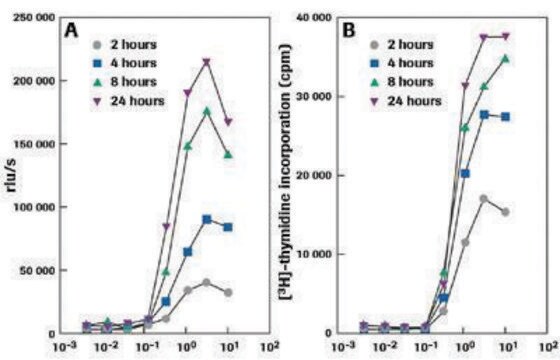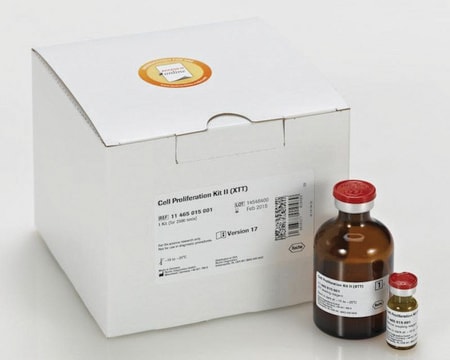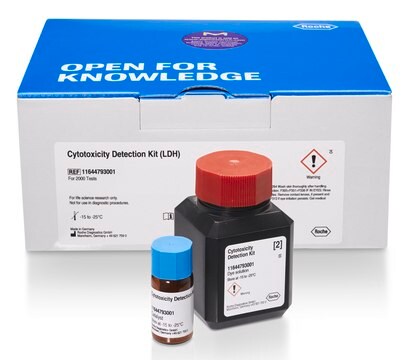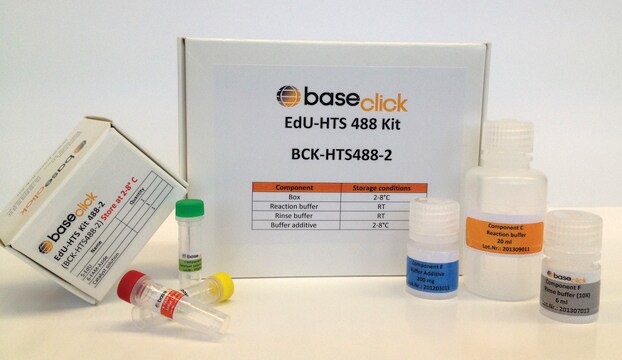推荐产品
一般說明
特異性
應用
细胞增殖试ELISA, BrdU(比色法)属于对DNA合成进行测量的第二代更新试剂盒。它是一种精准、快速且简单的比色方法,可替代在复制(周期内)细胞内DNA合成过程中基于BrdU插入测量的细胞增殖定量检测。因此,细胞增殖ELISA可用于许多不同体外细胞系统。例如:
- 生长因子和细胞因子介导的细胞增殖检测和定量
- 测定多种化合物在环境和生物医学研究中的抑制或刺激效应,应用于食品、化妆品及制药行业
- 测定由分裂原或抗原刺激的淋巴细胞免疫反应性
- 在医学研究中肿瘤细胞对不同细胞增殖抑制药物的化学敏感性
- 检测在骨组织工程中用于骨细胞生长的多种支架的生物兼容性
包裝
準備報告
工作溶液:BrdU标记溶液
用无菌的培养基按1:100对BrdU标记试剂进行稀释(生成的浓度:100 μM BrdU)。
对于一块96孔板, 如果细胞按100 μl /孔(10 μl/孔)培养则需要1 ml BrdU标记溶液而按200 μl /孔(20 μl/孔)培养则需要2 ml BrdU标记溶液。
抗BrdU-过氧化物酶储备溶液
将抗BrdU-过氧化物酶溶解于1.1 ml 双蒸水中10分钟并充分混匀。
抗BrdU-过氧化物酶工作溶液
用抗体稀释液按1:100将抗BrdU-过氧化物酶进行稀释。对于一块96孔板,将100 μl抗BrdU-过氧化物酶稀释于10 ml抗体稀释液中
洗涤溶液
用双蒸水按1:10进行洗涤缓冲液稀释。
对于一块96孔板,用90 ml双蒸水将10 ml洗涤缓冲液进行稀释。
储备条件(工作溶液):BrdU标记溶液
未稀释的BrdU标记试剂(1000x):在2至8°C避光可保存数月。
稀释的BrdU标记试剂:在2至8°C可稳定数周。避光保存。如需长期保存,推荐将BrdU标记溶液分装储存在-15至-25 °C。
抗BrdU-过氧化物酶储备溶液
在2至8°C可保存数月。如需长期保存,推荐将溶液分装储存在-15至-25 °C。
抗BrdU-过氧化物酶工作溶液
在使用前不久制备。请勿进行储备。
洗涤溶液
在2至8 °C下储存长达一周。
重構
其他說明
仅试剂盒组分
- BrdU Labeling Reagent
- FixDenat ready-to-use
- Anti-BrdU-peroxidase antibody
- Antibody Dilution Solution ready-to-use
- Washing Buffer PBS 10x concentrated
- Substrate Solution TMB ready-to-use
訊號詞
Danger
危險分類
Eye Irrit. 2 - Flam. Liq. 2 - Muta. 1B - Skin Sens. 1
儲存類別代碼
3 - Flammable liquids
水污染物質分類(WGK)
WGK 1
其他客户在看
商品
Regulation of the cell cycle involves processes crucial to the survival of a cell, including the detection and repair of genetic damage as well as the prevention of uncontrolled cell division associated with cancer. The cell cycle is a four-stage process in which the cell 1) increases in size (G1-stage), 2) copies its DNA (synthesis, S-stage), 3) prepares to divide (G2-stage), and 4) divides (mitosis, M-stage). Due to their anionic nature, nucleoside triphosphates (NTPs), the building blocks of both RNA and DNA, do not permeate cell membranes.
Cell based assays for cell proliferation (BrdU, MTT, WST1), cell viability and cytotoxicity experiments for applications in cancer, neuroscience and stem cell research.
实验方案
Cell Proliferation ELISA, BrdU (colorimetric) Protocol & Troubleshooting
我们的科学家团队拥有各种研究领域经验,包括生命科学、材料科学、化学合成、色谱、分析及许多其他领域.
联系技术服务部门













